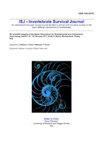Harpalus (Pseudoophonus) rufipes as a model to study cellular and humoral immune defence strategies in coleopteran species
IF 1.2
4区 农林科学
Q4 IMMUNOLOGY
引用次数: 2
Abstract
Carabids are of special interest as environmental quality assessment indicators of exposure to xenobiotic and for pest control. In agroecosystems, they can be exposed to a wide range of pathogens and environmental pollution exerting a stronger selection on their innate immune systems. Therefore, information on species-specific immunocompetence is necessary to complete the ecological framework of ground beetles. In this study, cellular and humoral responses were characterized in adults of Harpalus (Pseudoophonus) rufipes (De Geer, 1774) to define a baseline knowledge for future ecotoxicological studies. The circulating hemocytes were characterized by light and transmission electron microscopy and in vivo assay performed by injecting latex beads to identify phagocytizing hemocytes. Ultrastructural analyses revealed four morphologically distinct types of circulating hemocytes: prohemocytes, plasmatocytes, granular cells and oenocytoids. Differential hemocyte counts showed that plasmatocytes and granular cells were the most abundant circulating cell types and granular cells exhibited phagocytic activity following immune challenge with latex beads. Mitotic figures and non-differentiated hemocytes observed under light microscopy indicate a continuous cell turnover in the hemolymph. Melanotic nodules found 2h after the immune challenge were formed to immobilize the latex beads. Phenoloxidase (PO) assays revealed an increase of basal PO activity in hemolymph after immune system activation with lipopolysaccharide (LPS). However, the LPS-stimulated adults showed no significant variation in the lysozyme-like enzyme activity in hemolymph. Based on these results, H. rufipes displays a rapid, non-specific immune response involving cellular and humoral effectors that both sequester and clear pathogens.作为研究鞘翅目动物细胞和体液免疫防御策略的模型
瓢虫是特别感兴趣的环境质量评价指标暴露于外源和害虫防治。在农业生态系统中,它们可能暴露于各种各样的病原体和环境污染,对其先天免疫系统产生更强的选择。因此,了解种特异性免疫能力对完善地甲虫的生态框架是必要的。在这项研究中,细胞和体液反应的特征在成年Harpalus (Pseudoophonus) rufipes (De Geer, 1774),以确定未来的生态毒理学研究的基础知识。通过光学和透射电子显微镜对循环血细胞进行了表征,并通过注射乳胶珠进行了体内检测,以鉴定吞噬血细胞。超微结构分析显示了四种形态不同的循环血细胞:原血细胞、浆细胞、颗粒细胞和嗜酸细胞。不同的血细胞计数显示浆细胞和颗粒细胞是最丰富的循环细胞类型,颗粒细胞在乳胶珠免疫攻击后表现出吞噬活性。光镜下观察到的有丝分裂图和未分化的血细胞表明在血淋巴中有连续的细胞更新。在形成免疫攻击以固定乳胶珠2h后发现黑色结节。用脂多糖(LPS)激活免疫系统后,血淋巴中酚氧化酶(PO)活性增加。而lps刺激的成虫血淋巴溶菌酶样酶活性无明显变化。基于这些结果,猩红嗜血杆菌表现出一种快速的、非特异性的免疫反应,涉及细胞和体液效应,既隔离又清除病原体。
本文章由计算机程序翻译,如有差异,请以英文原文为准。
求助全文
约1分钟内获得全文
求助全文
来源期刊

ISJ-Invertebrate Survival Journal
IMMUNOLOGY-ZOOLOGY
CiteScore
2.10
自引率
0.00%
发文量
0
审稿时长
>12 weeks
期刊介绍:
Invertebrate Survival Journal (ISJ) is an international and open access journal devoted to prompt and innovative studies on the basic defense mechanisms in invertebrates, in particular with a view to identifying biotechnologies able to act against derived diseases and related economic damage.
Contributions will be mainly in the form of Letters to the Editor, Visions and Perspectives, Short Communications, Technical Reports, Research Reports, Review, Minireview and Reports of Meetings. Letters to the Editor can be commentaries or perspectives on invertebrate defence mechanisms or replies to the data published in ISJ.
 求助内容:
求助内容: 应助结果提醒方式:
应助结果提醒方式:


